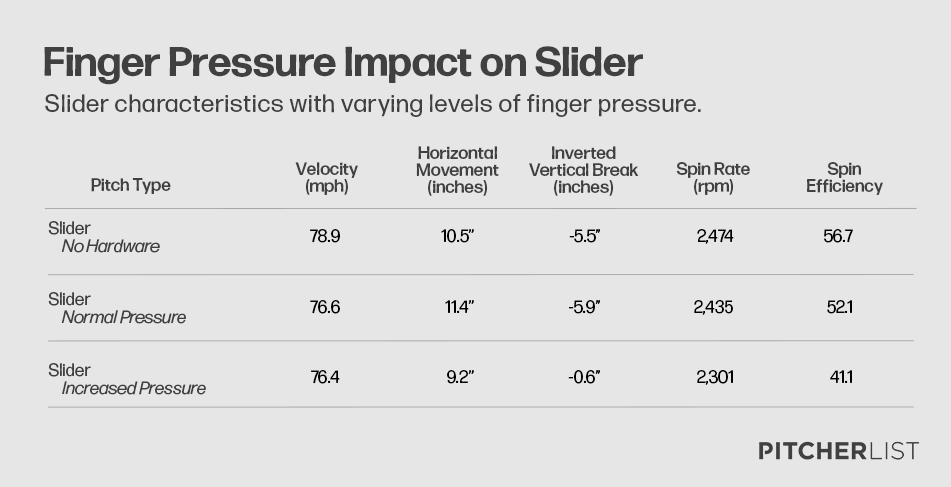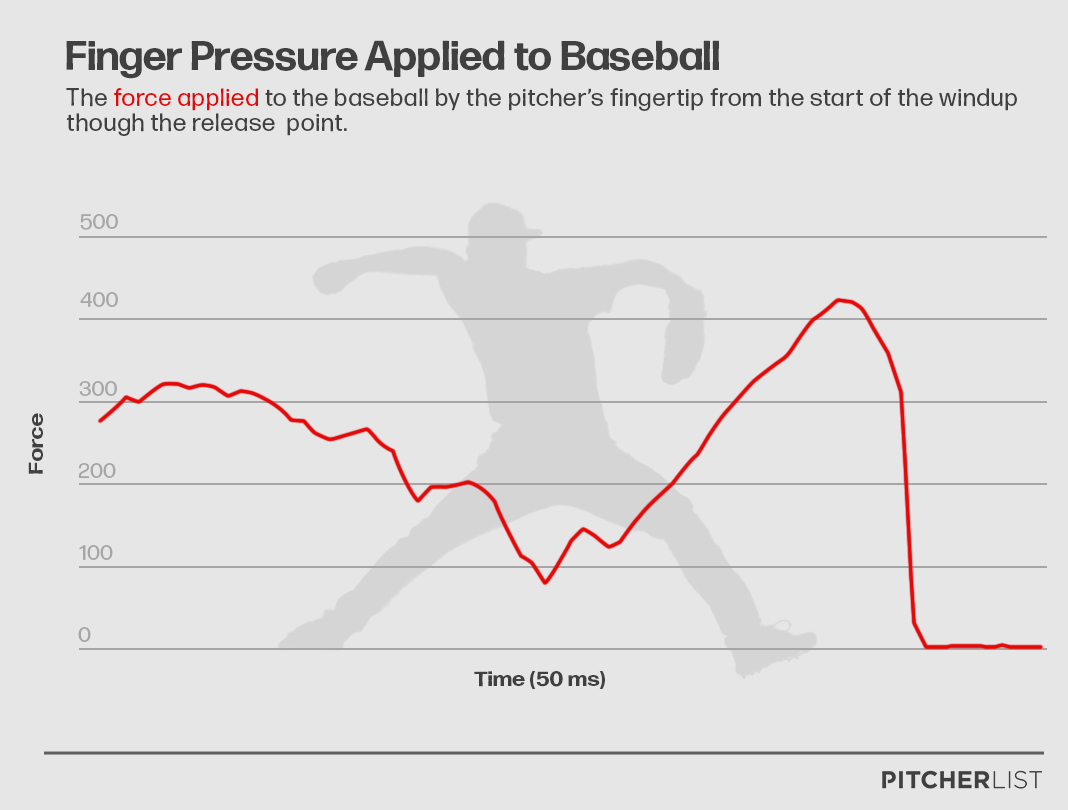Intro
The world of pitching development evolves at seemingly breakneck speed. Front offices and development programs are always looking to quantify what was previously thought unquantifiable and as a result utilize new data to gain a competitive advantage.
Take seam-shifted wake.
Less than a decade ago no one knew, concretely, what that was. Now seam-shifted wake is not only understood and quantified but can actually be taught, affording those who can do so a leg up on the competition. While it seems like everything there is to quantify has now been quantified, there’s another new frontier on the horizon. One that could provide a new foundation for the pitch design process and afford pitchers a new tool to help them maximize their arsenal’s potential: finger pressure.
Methodology and Technology
When I started questioning those in the baseball space about finger pressure, the answer that I got was very consistent: finger pressure matters.
“Pressure on different portions of the ball could impact the ball flight differently,” said Chris Langin, Director of Pitching at Driveline Baseball. “Specifically the middle finger could be very important…as pitchers with longer or bigger middle fingers often have different movement profiles.”
An MLB team consultant that I questioned about the potential impact of finger pressure asserted something similar. “If you’re increasing pressure on the ball, the ball could theoretically come off the finger a bit later and rotate on the finger as a result of staying in contact with the ball longer. This could be another degree of gyro spin and could theoretically lead to more gyro movement”.
This sentiment was echoed virtually to a person yet no one spoke of a sufficient way to actually quantify finger pressure in real time. Much like with spin efficiency or tilt, if we’re going to make concrete how impactful it is, we’ll need to change that. So I set out to determine how you could quantify the amount of pressure that is applied to a baseball from the beginning of a pitcher’s motion to its release.
The solution I came up with is now a patent-pending wearable that is equal parts durable, cost effective and minimally invasive. It allows pitchers to throw unencumbered and outputs finger pressure data in real-time.
With the tech in hand, I set out to quantify with the help one of baseball’s preeminent player development programs: Driveline Baseball.
Initial Study
The following initial study took place in mid-February and would not have happened without the help of Chris Langin, Joe Marsh, Brandon Mann, Juan Rodriguez and Josh Herzenberg. In this initial study I was focused on quantifying finger pressure data in real time and outputting enough data to assess whether or not increasing or decreasing the amount of finger pressure when applied to a ball upon release would impact the ball flight in a meaningful way.
I had the pitchers that I worked with – Brandon and Juan – throw just four-seamers and sliders and focused solely on capturing finger pressure data from the index and middle fingers. Specifically, the position on each digit where each pitcher felt they applied the most pressure. Over the course of two days, Brandon and Juan threw without the hardware, with the hardware exerting the amount of pressure that felt most “normal” to them and finally with the hardware and increased finger pressure. The measurements were taken roughly every 50 milliseconds and were output in simply “units”.
There is a remaining crucial piece of context: this is an initial study meant to prove out the viability of finger pressure. The sample sizes that were gathered are not substantial enough to form ground truths and the results hereafter will need to be substantiated with additional data.
With that said, let’s take a look at some of the initial studies findings.
Results & Their Importance
Four-seam Fastball
When it came to the four-seam fastball we saw the following results:

While we saw a drop in overall velocity, we saw an increase in spin, meaning we saw a jump in spin to velocity ratio. Spin to velocity ratio (simply spin / ratio) is a metric that helps contextualize spin rate. For example, Pitcher A and Pitcher B both throw a four-seam with 2200 RPM. Pitcher A has a velocity of 98 mph while pitcher B has a velocity of 90 mph. While Pitcher A’s spin/velo ratio would be about about league average, Pitcher B’s would be above average as they get more spin than one would typically see with that velocity.
While this doesn’t mean that one pitch is better than the other per se, it is a helpful metric in informing pitchers as to the optimal way their four-seamer should be utilized. Providing a pitcher a tool to help them better their spin to velocity ratio has the potential to be very impactful.
We also noticed a change in the movement profile of the four-seamer as the pitch picked up some additional cut as well as an increase in induced vertical break. Considering elevating your four-seamer is very much the name of the game right now, this is a very exciting finding.
It’s important to note that these findings were relative to the pitcher who was throwing the ball. This pitcher is a natural supinator who largely leaned on a slider during their big league career. Their mechanics, velocity band, and movement profile are unique to them.
While it’s difficult to say that an increase in finger pressure led to a “better” movement profile for the above four-seamer, I feel confident in saying that increased finger pressure led this pitcher to throw a more dead zone heater to something a bit more league average. The key takeaway however, is not that the pitch inherently got better or worse but more so that by changing the amount of finger pressure applied we can meaningfully change a pitches movement properties.
Slider

When it came to the slider we saw a significant change in the movement profile; just look at that change in vertical movement! When no pressure was applied, we saw a good amount of vertical and horizontal break to the slider which really could be better categorized as more of a slurve. When pressure was applied we noticed the movement profile changed to more of a sweeper with a drop in vertical break while maintaining a good amount of horizontal movement.
It was posited earlier that middle finger pressure could potentially be very impactful and this seemed to confirm that as we noticed a drop in the overall spin rate and an increase in the gyro spin.
Again, the context of who was throwing is really important here, but it’s worth noting that when there was increased pressure on the middle finger, this pitcher’s slider took on more of a sweeper tendency considering the game seems to be heavily skewing towards sweepers at the moment.
Overall

This is finger pressure measured every 50 milliseconds from when a pitcher begins his motion to when the pitch is delivered. That peak on the far right represents acceleration into ball release. We were able to get a few of these readings and noticed that the standard deviation between peak points before release was fairly minimal indicating that pitchers are able to sustain the amount of pressure they exert moments before a pitch is released on a pitch by pitch basis.
Being able to capture this data affords us so many opportunities:
- We can study the standard deviation of release point finger pressure over the course of a bullpen to determine if fatigue is setting in.
- We can determine if the amount of finger pressure at release is the same between pitch one of a bullpen in May and pitch 25 of a bullpen in July.
- We can see if certain players are predisposed to more finger pressure. For example, if they’re “weaker” than average can we increase their strength to benefit their movement profile.
- We can determine which mechanics profile corresponds to which amount of finger pressure. For example, natural supinators are more prone to increased middle finger pressure.
And so much more.
The last finding of this initial study was more-so anecdotal but potentially impactful.
Injury Concerns
Brandon Mann, the pitcher who was instrumental in helping me gather this data, pitched with the Rangers at the big league level, and pitched in Japan, Korea and Taiwan before getting hired at Driveline as a lead throwing trainer. After throwing a lot of pitches with increased pressure he began to notice a bit of a soreness in his elbow; something he’s really never experienced before in his life. This was significant because last year, after MLB cracked down on pitchers applying sticky substances to the baseball, Tampa Bay Rays pitcher Tyler Glasnow hit the IL with an elbow injury. Glasnow mentioned that he was, “taking a fastball and squeezing it twice as hard”.
While a significant amount of data would be needed to prove this I did find it anecdotally interesting that Brandon experienced similar pain. Quantifying finger pressure will not solve the ongoing Tommy John epidemic but it is important to know that it could be a contributing factor.
Next Steps
While the initial study suggests that finger pressure is important and that quantifying it can be an incredibly powerful tool, it bears repeating that the sample that was captured was not significant enough to form ground truths; there’s many data points that still need to be gathered. I hope to be returning to Driveline in April where I will look to gather as many different types of pitchers as possible – pronators, supinators, guys with high release points, etc – and gather finger pressure data on different parts of different digits. In doing so, we’ll be able to get an even more accurate picture as to the importance of finger pressure.
While the focus was specifically on the impacts of finger pressure on a baseball, any sport that prominently features a thrown ball could stand to benefit from similar studies. I’m already in contact with football programs to begin studying the impacts of finger pressure on thrown footballs and am curious to see what other applications could exist for sports like softball and cricket.
Conclusion
A few hours before the intitial study began at Driveline I was able to sit in on a pitch design decision where Brandon was working with a minor league pitcher in an attempt to add a new splitter to his repertoire. “I want you to think 60/40” Brandon told him; when referring to how much pressure should be applied to the index and middle finger.
Finger pressure, in some capacity, is already incorporated into how pitchers train. What’s so exciting is the fact that we can now actually quantify those numbers and prove their importance. We can say, “you applied 200 units of force, let’s try to get you to 250”. As a result we can get more granular and form new foundations from which pitchers, trainers and front offices can operate.
Just as a pitcher is now able to throw a pitch and get immediate feedback via the Trackman on how much vertical break they’re getting or how spin efficient they are, we now have a tool that can give immediate feedback on the pressure they’re applying. They can now figure out how to optimize their finger pressure and turn that into a physical cue for them to keep in mind while pitching.
We’ve taken something that was previously unquantifiable and quantified it, giving pitchers a new weapon to utilize in their training and while we’ve just scratched the surface, I’m confident that we’re on the frontier of pitching’s next great data-driven opportunity.
Images by Justin Paradis (@JustParaDesigns on Twitter)

Wow, this is cool. Have you considered finger pressure for bat gripping and what it means for swing speed, control, or plane?
Thanks, Sean!
thank you for the information